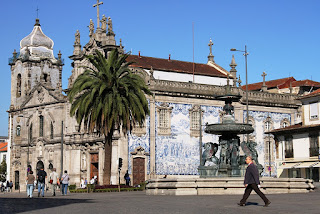Stunning moonlight accompanied the overnight sail towards Portugal and the port of Leixoes, just 10 km drive away from the centre of Porto.
Vímara Peres, was sent by King Alfonso III of Asturias, Leon and Galicia,to regain from the Moors the area from the Minho River to the Douro River including the city of Portus Cale later named Porto and Gaia from where the name of Portugal emerged. A statue of this 9th Century hero stands next to the Cathedral.
At the mouth of the River Douro the local fishermen were fixing the nets used from their small boats. A little further inland the port wine warehouses nestle together on the opposite river bank from the civic centre. Joining the two is Gustav Eiffel's distinctive iron bridge, carrying road and tram traffic on different levels.
Port is a fortified wine produced exclusively in the demarcated Douro Valley Region. Helped by the microclimate around one hundred different varieties of grape are grown. Typically a sweet, red wine is produced, often served as a dessert wine, but there are also dry, semi-dry, and white varieties.
 In the early history of the port wine trade, many of the most powerful traders were English families. Over the years Portuguese, as well as Dutch, German and Scottish-owned shippers became prevalent in the port industry. Fram's guests visited the warehouses of rivals Calem and Sandeman. Tasting, of course, the only way to appreciate this particular heritage of Porto!
In the early history of the port wine trade, many of the most powerful traders were English families. Over the years Portuguese, as well as Dutch, German and Scottish-owned shippers became prevalent in the port industry. Fram's guests visited the warehouses of rivals Calem and Sandeman. Tasting, of course, the only way to appreciate this particular heritage of Porto!





